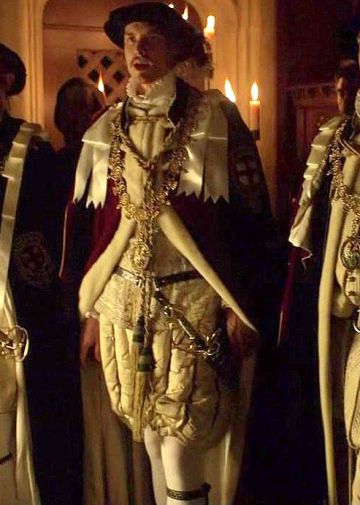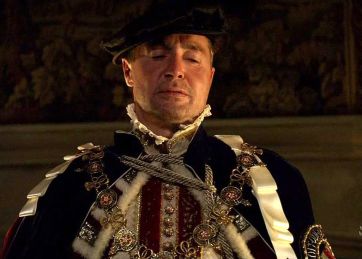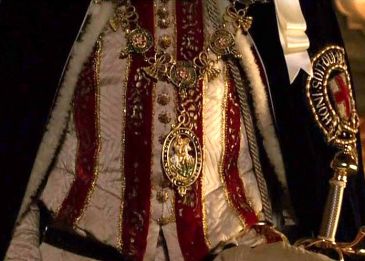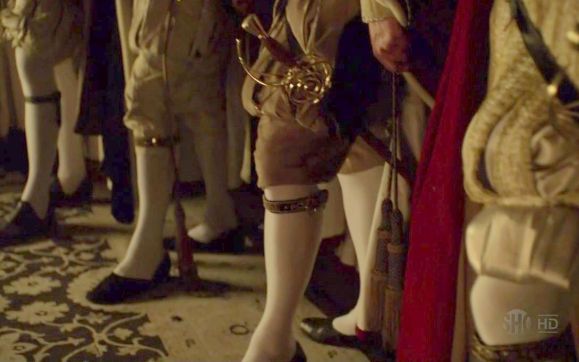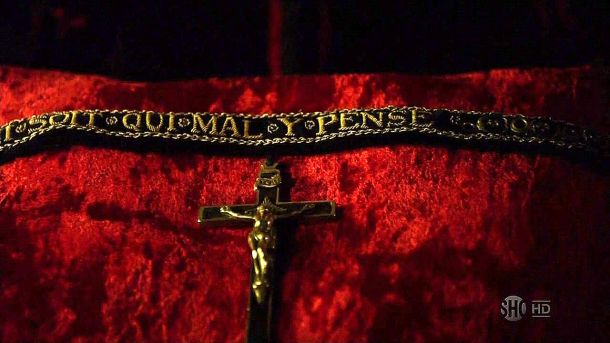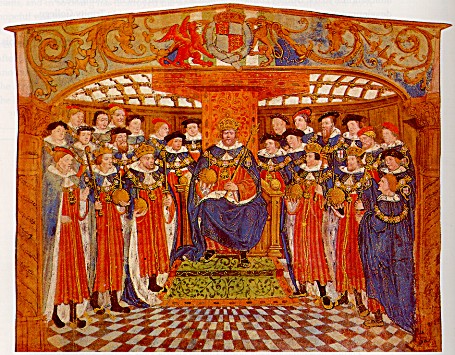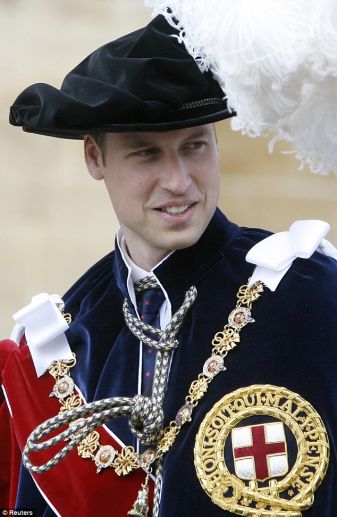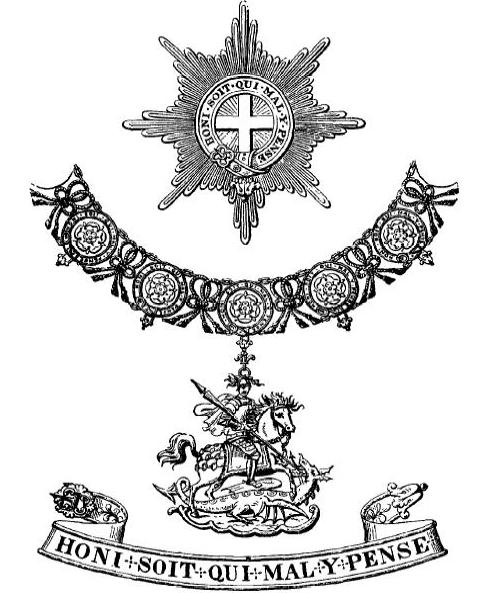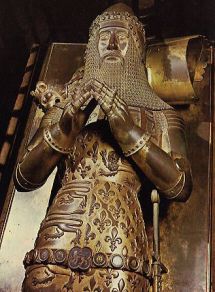 - 1 (inv 1348) Edward, Prince of Wales (Founder). Known since 1569 as the "Black Prince." The hero of the battles of Crécy and Poitiers. He died in his father's lifetime.
- 2 (inv 1348) Henry (Plantagenet), styled "of Lancaster" (Founder). Earl of Derby. Afterwards Duke of Lancaster. Served in the wars against the Scots, the Dutch, and French. Admiral of the Fleet and Steward of England.
- 3 (inv 1348) Thomas (Beauchamp), 3rd Earl of Warwick (Founder). Marshal of England. Fought at the battles of Crécy and Poitiers.
- 4 (inv 1348) Sir John de Grailly, Vicomte de Benanges et Castillon. Captal (i.e. Governor) de Buch. One of the Founders of the Order. Fought under the Black Prince at Poitiers.
- 5 (inv 1348) Ralph, 1st Earl of Stafford (Founder). Served in the Scotch and French wars and in important diplomatic missions in European countries.
- 6 (inv 1348) William (de Montacute), 2nd Earl of Salisbury. One of the Founders of the Order. In the wars of his time he was chiefly distinguished in naval actions. He was the last survivor of the Founders.
- 7 (inv 1348) Roger (Mortimer), 3rd Earl of March (Founder). Attended the King into France while yet under age and served later in expeditions under John of Gaunt.
- 8 (inv 1348) Sir John de Lisle, afterwards 1st Lord Lisle de Rougemont. One of the Founders of the Order. Granted a manor at the age of 17 to enable him to serve in the wars, in which he won great fame.
- 9 (inv 1348) Sir Bartholomew Burghersh (Founder). Served with distinction in the French wars.
- 10 (inv 1348) Sir John Beauchamp (Founder). Afterwards Lord Beauchamp de Warwick. He carried the Standard Royal at the battle of Crécy Present at the surrender of Calais and the battle of Sluys.
- 11 (inv 1348) John, 2nd Lord Mohun. One of the Founders of the Order. Served in the wars under the Black Prince.
- 12 (inv 1348) Sir Hugh Courtenay. One of the Founders of the Order. Served with the King in France.
- 13 (inv 1348) Sir Thomas Holland (Founder). Afterwards 1st Earl of Kent. Married the "Fair Maid of Kent", widow of the Black Prince. In chief command of the van at the battle of Crécy.
- 14 (inv 1348) Sir John Grey (Founder). Distinguished in the French wars.
- 15 (inv 1348) Sir Richard Fitz-Simon (Founder). One of the three who stood over the Black Prince when struck down at the battle of Crécy
- 16 (inv 1348) Sir Miles Stapleton. One of the Founders of the Order. Fought at the siege of Calais and at the Battle of Crécy.
- 17 (inv 1348) Sir Thomas Wale (Founder). Attended Edward III into Flanders in 1339 and served in the expedition to Brittany in 1342.
- 18 (inv 1348) Sir Hugh Wrottesley (Founder). On service in Flanders in 1338.
- 19 (inv 1348) Sir Male Loryng. One of the Founders of the Order. Distinguished at the battle of Blurs. Attended the Black Prince into Gascony. Fought at the battle of Poitiers.
- 20 (inv 1348) Sir John Chandos. One of the Founders of the Order. Fought at Crécy and Poitiers.
- 21 (inv 1348) Sir James Audley (Founder). Fought at the battle of Sluys, and with great distinction at Poitiers, where he was severely wounded.
- 22 (inv 1348) Sir Otho Holland (Founder). Brother of Thomas Holland, Earl of Kent, also a Founder; whom he accompanied into Brittany, where he was taken prisoner. Later he was Governor of the Channel Islands.
- 23 (inv 1348) Sir Henry Earn (Founder). Entrusted by the Black Prince with a mission to Brabant.
- 24 (inv 1348) Sir Sanchet D'Abrichecourt. One of the Founders of the Order.
- 25 (inv 1348) Sir Walter Paveley. One of the Founders of the Order.
|
- <a name="radcliffe">246 (inv c.1495) Henry (Tudor), Duke of York. - aged 4 Created PRINCE OF WALES in 1502 on the death of his brother Arthur.</a>Later KING Henry VIII
- <a name="radcliffe">247 (app c.1495) Henry Algernon (Percy), 5th Earl of Northumberland. Fought at the battle of the Spurs.</a>
- <a name="radcliffe">248 (inv 1495) </a>Edward Stafford, 3rd Duke of Buckingham Degraded 1521 & beheaded.
- <a name="radcliffe">249 (inv c.1496) Charles (Somerset), 1st Earl of Worcester.</a>
- <a name="radcliffe">250 (inv 1496) Edmund (de la Pole), 8th Earl of Suffolk. On accepting the accession of Henry VII he surrendered his claim to the Dukedom of Suffolk. Degraded 1500. Beheaded 1513.</a>
- <a name="radcliffe">251 (c.1496d) Henry (Bourchier), 2nd Earl of Essex. Bore the Sword of State at </a>the Field of Cloth of Gold
- <a name="radcliffe">252 (inv 1498) Sir Thomas Lovell. Supporter of Henry VII, and fought at the battle of Bosworth. Speaker of the House of Commons. He built the gate-house at Lincoln's Inn.</a>
- <a name="radcliffe">253 (app 1499) Sir Richard Pole.</a>
- <a name="radcliffe">254 (app c.1500) Sir Richard Guildford. A trusty councillor of Henry VII. Died on a pilgrimage to the Holy Land.</a>
- <a name="radcliffe">255 (inv 1500) Sir Reginald Bray. A close friend of Henry VII.</a>
- <a name="radcliffe">256 (inv 1501) Thomas (Grey), 2nd Marquess of Dorset. one of the eight "Challengers" at the Field of the Cloth of Gold.</a>
- <a name="radcliffe">257 (inv 1503) Philip, Archduke of Austria. Afterwards Philip I, King of Castile.</a>
- <a name="radcliffe">258 (inv 1503) Gerald (FitzGerald), 8th Earl of Kildare. Surnamed "Gerald the Great." Supporter of Lambert Simnel. Defeated Perkin Warbeck near Galway,</a>
- <a name="radcliffe">259 (app c.1504) Guidobaldo (da Montefeltro), 2nd Duke of Urbino.</a>
- <a name="radcliffe">260 (app 1505) Richard (Grey), 3rd Earl of Kent. Present at the Field of the Cloth of Gold.</a>
- <a name="radcliffe">261 (inv c.1505) Lord Henry Stafford. Afterwards 3rd Earl of Wiltshire. 2nd son of Henry, 2nd Duke of Buckingham.</a>
- <a name="radcliffe">262 (app c.1505) Sir Rhys ap Thomas Fitz-Urian. An ardent supporter of Henry VII.</a>
- <a name="radcliffe">263 (inv 1507) Sir Thomas Brandon.</a>
- <a name="radcliffe">264 (app 1508) Charles, Archduke of Austria. Afterwards the Emperor </a>Charles V
- <a name="radcliffe">265 (inv 1509) Thomas, 1st </a>Lord Darcy. Warden of the Scots Marshes. Joined in the Pilgrimage of Grace. Convicted of high treason and beheaded. Degraded 1537.
- <a name="radcliffe">266 (inv 1509) Edward (Sutton), 6th Lord Dudley.</a>
- <a name="radcliffe">267 (app 1510) Emanuel, King of Portugal. (Not installed.)</a>
- <a name="radcliffe">268 (inv 1510) Sir </a>Thomas Howard, 3rd Duke of Norfolk. Fought at Flodden. Degraded 1547, restored 1553.
- <a name="radcliffe">269 (inv 1510) Sir Henry Marny. Afterwards Lord Marny. Lord Privy Seal. Fought at the battles of Stoke and Blackheath.</a>
- <a name="radcliffe">270 (inv 1510) Thomas (West), 8th Lord de la Warr. Favoured Henry VIII's divorce and had large grants of monastic lands.</a>
- <a name="radcliffe">271 (inv 1513) George (Nevill), 5th Lord Bergavenny.Served in the wars in France.</a>
- <a name="radcliffe">272 (app 1513) Sir Edward Howard. (Died before installation.)</a>
- <a name="radcliffe">273 (inv 1513) </a>Charles Brandon, 1st Duke of Suffolk. He married Mary, the younger daughter of Henry VII and widow of Louis XII, King of France.
- <a name="radcliffe">274 (app 1514) Giuliano de Medici, Duc de Nemours, brother of Pope Leo X. (Not installed.)</a>
- <a name="radcliffe">275 (inv 1514) Sir Edward Stanley. Afterwards 1st Lord Monteagle. Commanded the English army at Flodden. Younger son of Thomas, 1st Earl of Derby.</a>
- <a name="radcliffe">276 (inv 1518) Thomas, 3rd Lord Dacre of Gillesland. Fought at the Battle of Flodden.</a>
- <a name="radcliffe">277 (inv 1518) Sir William Sandys. Afterwards Lord Sandys of the Vyne.</a>
- <a name="radcliffe">278 (inv 1521) Henry (Courtenay), created Marquess of Exeter. Assisted in the suppression of the Pilgrimage of Grace. Later he was accused of conspiracy, found guilty and beheaded. Degraded 1539.</a>
- <a name="radcliffe">279 (inv 1524) Ferdinand, Archduke of Austria. Afterwards the Emperor Ferdinand I. Brother of the Emperor Charles V.</a>
- <a name="radcliffe">280 (inv 1522) Sir Richard Wingfield. Soldier and diplomatist; in high favour with Henry VIII.</a>
- <a name="radcliffe">281 (inv 1523) </a>Sir Thomas Boleyn, Earl of Wiltshire and Ormonde. Father of Anne Boleyn and grandfather of Queen Elizabeth.
- <a name="radcliffe">282 (inv 1523) Walter (Devereux), 9th Lord Ferrers. Present at the capture of Boulogne. Afterwards 1st Viscount Hereford.</a>
- <a name="radcliffe">283 (inv 1525) Arthur (Plantagenet), Viscount Lisle. Natural son of Edward IV.</a>
- <a name="radcliffe">284 (inv 1524) Robert (Radclyffe), 10th Lord FitzWalter. Afterwards 1st Earl of Sussex. Present at the sieges of Tournay and Therouenne.</a>
- <a name="radcliffe">285 (inv 1525) William (Fitzalan), 11th Earl of Arundel.</a>
- <a name="radcliffe">286 (inv 1525) Thomas (Manners), 1st Earl of Rutland. Present with Henry VIII at the Field of the Cloth of Gold. Son and heir of George, 12th Lord Ros.</a>
- <a name="radcliffe">287 (inv 1525) Sir </a>Henry Fitzroy (aged 6) Afterwards Duke of Richmond and Somerset. Son of King Henry VIII and Elizabeth Blount.
- <a name="radcliffe">288 (inv 1525) Ralph (Nevill), 4th Earl of Westmorland. Present at the Field of the Cloth of Gold.</a>
- <a name="radcliffe">289 (inst 1526) William (Blunt), Lord Mountjoy.</a>
- <a name="radcliffe">290 (inv 1526) Sir William Fitzwilliam. Afterwards 1st Earl of Southampton. Served with distinction against the Scots and French, and on important diplomatic missions.</a>
- <a name="radcliffe">291 (inv 1526) Sir Henry Guildford. A favourite courtier of Henry VIII</a>
- <a name="radcliffe">292 (inv 1527) </a>Francis I, King of France.
- <a name="radcliffe">293 (inv 1527) John (de Vere), 15th Earl of Oxford. Knighted at the battle of the Spurs.</a>
- <a name="radcliffe">294 (inst 1531) Henry (Percy), earl of Northumberland.</a>
- <a name="radcliffe">295 (inv 1533) Anne (de Montmorency), Comte de Beaumont, later duc de Montmorency. Afterwards Duc de Montmorency. Constable of France. Mortally wounded at the battle of St. Denis in 1567.</a>
- <a name="radcliffe">296 (inv 1532) </a>Philippe de Chabot<a name="radcliffe"> , Comte de Charny and Buzançais , d. 1543 (Neublanche in English rolls).</a>
- <a name="radcliffe">297 (inv 1535) James V, King of Scotland. Father of Mary, Queen of Scots and nephew of Henry VIII.</a>
- <a name="radcliffe">298 (inv 1536) Sir Nicholas Carew. A favourite courtier of Henry VIII. Entrusted with various diplomatic missions. Attainted and beheaded. Degraded 1539.</a>
- <a name="radcliffe">299 (inv 1537) Henry (Clifford), 1st Earl of Cumberland.</a>
- <a name="radcliffe">300 (inv 1537) </a>Thomas Cromwell, Earl of Essex. Rose under Cardinal Thomas Wolsey's influence. Notorious in connection with the suppression of the monasteries. Lost favour with Henry VIII after introducing Anne of Cleves. Condemned as a traitor and beheaded. Degraded 1540.
- <a name="radcliffe">301 (inv 1539) Sir John Russell. Afterwards 1st Earl of Bedford. Lord High Admiral, Lord Privy Seal. Appointed to conduct Philip II of Spain to England.</a>
- <a name="radcliffe">302 (inv 1539) Sir Thomas Cheyney.</a>
- <a name="radcliffe">303 (inv 1539) Sir </a>William Kingston. Fought at the battle of Flodden. Took part in the tilting at the Field of the Cloth of Gold.
- <a name="radcliffe">304 (inv 1540) Thomas, Lord Audley of Walden. Lord Chancellor.</a>
- <a name="radcliffe">305 (inv 1540) Sir Anthony Browne. An executor of the will of Henry VIII.</a>
- <a name="radcliffe">306 (inv 1541) </a>Edward Seymour, Earl of Hertford. Afterwards Duke of Somerset. Brother of Queen Jane Seymour and Uncle of Edward VI, and Protector of England during his minority. Took part in many military operations in Scotland and France. Found guilty of conspiracy and beheaded.
- <a name="radcliffe">307 (inv 1541) </a>Henry Howard, Earl of Surrey. Son and heir of Thomas Howard, 3rd Duke of Norfolk. Field-Marshal of the army in France, but more famous as a poet. Executed for high treason, aged 30. Degraded 1547.
- <a name="radcliffe">308 (inv 1541) Sir John Gage. Statesman and military commander.</a>
- <a name="radcliffe">309 (inv 1541) Sir Anthony Wingfield. Served in the French wars. Present at the Field of the Cloth of Gold.</a>
- <a name="radcliffe">310 (inv 1543) John (Dudley), 7th Viscount Lisle. Afterwards Earl of Warwick and Duke of Northumberland. Beheaded 1553.</a>
- <a name="radcliffe">311 (inv 1543) William (Paulet), Lord St. John of Basing. Afterwards 1st Marquess of Winchester. High Treasurer of England. Joined in the overthrow of the Protector Somerset.</a>
- <a name="radcliffe">312 (inv 1543) </a>William Parr Marquess of Northampton. Brother of Catherine Parr, Queen of Henry VIII. Originally appointed in 1543, he was degraded from the Order in 1552 as a supporter of Lady Jane Grey's cause, but re-elected in 1559.
- <a name="radcliffe">313 (inv 1544) Sir John Wallop. Soldier and diplomatist.</a>
- <a name="radcliffe">314 (inv 1544) Henry (Fitzalan), 12th Earl of Arundel. Present at the capture of Boulogne. Married, firstly, Catherine daughter of Thomas, 1st Marquess of Dorset, K.G., aunt of Lady Jane Grey.</a>
- <a name="radcliffe">315 (inv 1544) Sir Anthony St. Leger. Lord Deputy of Ireland.</a>
- <a name="radcliffe">316 (inv 1545) Francis (Talbot), 5th Earl of Shrewsbury. Took part in the Scottish invasion. Lord President of the Council of the North.</a>
- <a name="radcliffe">317 (inv 1545) Thomas, Lord Wriothesley. (</a>Risley) Afterwards 1st Earl of Southampton. Lord Chancellor.
- <a name="radcliffe">318 (inv 1547) Henry (Grey), 3rd Marquess of Dorset. Afterwards Duke of Suffolk. Father of Lady Jane Grey; and having proclaimed her Queen after the death of Edward VI, was attainted. Degraded 1554. </a>
- <a name="radcliffe">319 (inv 1547) Edward (Stanley), 3rd Earl of Derby. "With his death the glory of hospitality seemed to fall asleep." -Camden.</a>
- <a name="radcliffe">320 (inv 1547) </a>Thomas Seymour Sudeley. Brother of Edward Seymour, Duke of Somerset, the Protector against whom he conspired. Executed at the Tower. Degraded 1549.
- <a name="radcliffe">321 (inv 1547) Sir William Paget. Afterwards 1st Lord Paget de Beaudesert. Degraded 1552, restored 1553.</a>
|
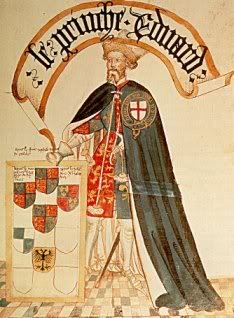 It was thought that in 1344 King Edward III inspired by the legend of King Arthur and the Knights of the Round Table, made a spectacular demonstration of his interest in Arthurian legend during a massive joust at Windsor Castle. He also promised to renew King Arthur's fraternity of knights with al lthe paragons of knightly virtues with a complement of 300 men. Work also even began on a gigantic circular building two-hundred feet across within the upper ward of the castle to house this so-called Order of the Round Table. The renewal of war with France intervened with this project but in 1348 it was revived in a different guise.
It was thought that in 1344 King Edward III inspired by the legend of King Arthur and the Knights of the Round Table, made a spectacular demonstration of his interest in Arthurian legend during a massive joust at Windsor Castle. He also promised to renew King Arthur's fraternity of knights with al lthe paragons of knightly virtues with a complement of 300 men. Work also even began on a gigantic circular building two-hundred feet across within the upper ward of the castle to house this so-called Order of the Round Table. The renewal of war with France intervened with this project but in 1348 it was revived in a different guise.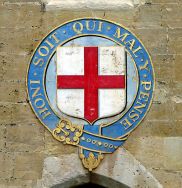
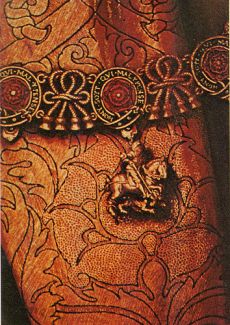 priate to use the garter as a symbol of binding together in common brotherhood. Whilst the motto probably refers to the leading political topic of the 1340's, Edward's claim to the throne of France. The patron saint of the Order of the Garter is St George and as he is the patron saint of soldiers and also of England, the spiritual home of the order has therefore always been St George's Chapel in Windsor Castle.
priate to use the garter as a symbol of binding together in common brotherhood. Whilst the motto probably refers to the leading political topic of the 1340's, Edward's claim to the throne of France. The patron saint of the Order of the Garter is St George and as he is the patron saint of soldiers and also of England, the spiritual home of the order has therefore always been St George's Chapel in Windsor Castle.